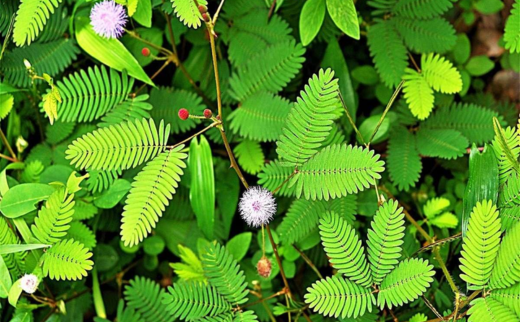Touch me Not Plant / Lajjalu/ Mimosa pudica Linn. – Ayurvedic Uses, Benefits, Dosage & Therapeutic Actions
Abstract
Mimosa pudica Linn., commonly known as the “Touch-me-not” plant, is a sensitive and creeping herb valued for its unique leaf-folding behaviour and diverse medicinal properties. It holds an important place in traditional Ayurvedic medicine for treating disorders related to the nervous system, skin and gastrointestinal tract. The plant is widely distributed in tropical regions and is known for its antioxidant, anti-inflammatory and antimicrobial effects. Modern studies have validated many of its traditional uses, confirming its pharmacological potential. This article outlines its Ayurvedic identity, vernacular names, habitat, morphology, therapeutic applications and home remedies.

Introduction
Mimosa pudica is widely recognised by various names such as Sensitive Plant, Sleepy Plant, Action Plant, Touch-me-not and Shame Plant. It is a creeping annual or perennial herbaceous plant belonging to the Fabaceae (pea/legume) family. The plant is characterised by its slender, thorn-covered stems and delicate grey-green leaflets that fold inward when touched or during nighttime. It is known for a broad range of pharmacological actions, including antibacterial, antivenom, antifertility, anticonvulsant, antidepressant and aphrodisiac properties. Traditionally, Mimosa pudica has been employed in treating urogenital issues, piles, dysentery, sinus conditions and for healing wounds through topical applications.
Scientific Classification
- Kingdom: Plantae
- Order: Fabales
- Family: Fabaceae
- Subfamily: Mimosoideae
- Genus: Mimosa
- Species: Mimosa pudica Linn.
Synonyms
- Lajjalu – Sensitive plant; leaves fold instantly when touched.
- Samanga – The plant appears proportionate and symmetrical.
- Sankochani – Leaves fold like hands in salutation on contact.
- Namaskari – Folds leaves in a gesture resembling a respectful greeting.
- Khadira Patrika – Its foliage resembles that of Khadira (Acacia catechu).
- Raktapada – Characterised by coppery-red colored roots.
- Raktamoola – Characterised by coppery-red colored roots.
- Tamramoola – Characterised by coppery-red colored roots.
- Gandhakari – Emits a distinctive natural aroma.
- Khadirikaruna – Shares traits with Khadira, especially leaf structure.
- Prarochani – Enhances taste perception and stimulates appetite.
- Shamipatra – Leaves closely resemble those of the Shami plant.
- Jalakarika – Often thrives in moist or semi-aquatic environments.
- Prasarini – Grows rapidly and spreads horizontally across the ground.
Vernacular Names
- English – Touch-me-not, sensitive plant, sleepy plant
- Hindi – Lajwanti, Chhui-mui, Lajaaru, Laajwanti, Lajauni
- Punjabi – Lajan
- Urdu – Chhui-mui
- Marathi – Lajalu, Laajri
- Gujrati – Resamani
- Bengali – Lajjawati
- Tamil – Tittalvati
- Telugu – Munugu damragu
- Malayalam – Tottavati
- Kannada – Lajjavati
- Oriya – Lajakuri
Habitat
The species is native to Brazil, the Caribbean and South and Central America, but it has now become a pantropical weed. It is currently found in the southern United States, South Asia, East Asia, Micronesia, Australia and South Africa and is widespread throughout India.
Morphology
The root of Mimosa pudica is cylindrical, tapering, with secondary and tertiary branches, up to 2 cm thick, featuring a longitudinally wrinkled, rough, grayish-brown to brown surface and a hard, woody texture. Its stem is cylindrical, branched, about 1.5 meters long and 2.5 cm in diameter, with longitudinal grooves, light brown externally and greyish internally. It is erect in young plants but becomes creeping with age. The plant bears bipinnate, compound leaves with five sessile primary leaflets and linear-lanceolate stipules. Each leaf has 10–20 pairs of secondary leaflets measuring 0.6–1.2 cm long and 0.3–0.4 cm broad. These leaves are sensitive to touch, folding inward, hence the name “sensitive plant.” Flowers are small, pink and spherical (8–10 mm in diameter), appearing in globose heads from leaf axils during the rainy season. They are radially symmetrical with four lobes, four stamens and a sessile ovary with many ovules; pollination occurs via insects and wind. The fruit is a simple, dry, leguminous pod (1–1.6 cm long, 0.4–0.5 cm broad) forming clusters of 2–8 prickly pods that break into 2–5 segments, each containing pale brown seeds about 2.5 mm long. Seeds are compressed, oval-elliptic, brown to grey, 2.5 mm broad, with a hard seed coat that restricts germination.
Varieties
- Var. hispida Brenan.
- Var. tetranda DC.
- Var. unijuga Griseb.
Classical Categorisation
- As per Charaka Samhita – It is described under the Sandhanniya group (Group of herbs used for healing)
- As per Sushruta Samhita – Priyangvadi Gana, Ambashtadi Gana
- As per Vagbhata – Priyangvadi Gana
- As per Bhavaprakasha Nighantu – Guduchyadi Varga
- As per Kaiyadeva Nighantu – Oushadhi Varga
- As per Raj Nighantu – Parpatadi Varga
Ancient Verses
लज्जालुः शीतला तिक्ता कषाया कफपित्तजित |
रक्तपित्तमतिसारं योनिरोगान विनाशयेत ||
(भावप्रकाशनिघंटु गुडूच्यादि वर्गः 273)
According to the above Shloka, Lajjalu possesses a bitter and astringent taste along with a cold potency. It is beneficial in treating bleeding disorders, diarrhoea, and various uterine conditions. Additionally, it aids in balancing Kapha and Pitta Doshas.
Ayurvedic Properties
- Taste (Rasa) – Astringent (Kashaya), bitter (Tikta)
- Physical property (Guna) – Light (Laghu), Dry (Rooksha)
- Potency (Veerya) – Cold (Sheeta)
- Post-digestion effect (Vipaka) – Katu (Pungent)
- Effect on tridosha – Pacifies Kapha and Pitta dosha
Therapeutic Properties
- Anti-viral
- Anti-depressant
- Anti-fertility activity
- Diuretic
- Hyperglycemic
- Wound healing
- Anti-convulsant
- Anti-venom activity
- Aphrodisiac activity
- Hepatoprotective
Systemic Actions
External Use
- Lajjalu is highly effective in wound healing because of its hemostatic properties. It is also used to treat ulcers and fistulas.
Internal Use
- Digestive System – Useful in managing diarrhoea, dysentery and bleeding piles.
- Circulatory System – Acts as a blood purifier and anti-inflammatory agent owing to its astringent qualities.
- Reproductive System – The seeds are particularly effective in treating disorders related to semen.
- Urinary System – Helps in managing diabetes (Prameha).
Chemical Composition
- Mimosine
- Leucoanthocyanidins
- Stigmasterol
- Turgorin
- Alkaloids
- Flavonoids
- Phytosterol
- Amino Acid
- Tannins
- Phenol
- Cardiac glycosides
- Saponins
Modern Overview
Effect In Bleeding Disorders
Mimosa pudica contains potent phytochemicals such as tannins, especially gallic acid and tannic acid, which are primarily responsible for its hemostatic and astringent effects. These tannins exert their action by precipitating proteins at the site of injury, forming a protective barrier and promoting vasoconstriction, which reduces local blood flow and facilitates clot formation. Additionally, the plant is rich in total phenolic compounds, which enhance its antioxidant capacity, stabilise damaged tissues, and support wound healing. These bioactive constituents together make Mimosa pudica effective in managing bleeding disorders, particularly in cases of minor cuts, wounds, or mucosal bleeding. Studies have also indicated its potential in reducing capillary permeability, further contributing to its traditional use as a blood-clotting agent.
Practical Uses
- Low Sperm Count – Seed powder is administered in a dose of 4–6 grams to help increase sperm count.
- Diarrhoea – A decoction of the plant, 10–15 ml taken three times daily, is used to treat diarrhoea and bleeding piles.
- Menstrual Bleeding – Fresh juice of the plant, 15–20 ml, is used to manage heavy menstrual bleeding.
- Wounds – A paste made from the plant is applied to fresh wounds to stop bleeding.
Parts Used
- Whole plant
Dosage
- Juice – 10–20 ml
- Decoction – 50–100 ml
Planet Ayurvedic Medicines
- Mimosa-Di Capsules
- Coolstrin-C Capsules
- Coolstrin-B Capsules
- Shonit Stambhak Vati
- Hemostop Astringent Powder
Conclusion
Lajjalu (Mimosa pudica) is a widely recognised medicinal plant native to tropical regions but now found pantropical. Known for its sensitive leaves that fold upon touch, it holds significant value in traditional medicine, especially Ayurveda. The plant exhibits astringent and bitter tastes with a cooling potency, making it effective in treating bleeding disorders, digestive issues like diarrhoea, respiratory conditions and female reproductive ailments. Its versatile applications range from wound healing and anti-inflammatory effects to potential antifertility properties. Scientific studies also highlight its antivenom capabilities and hormonal influences. Overall, Lajjalu is a valuable herbal remedy with diverse therapeutic benefits, supporting its continued use in natural and traditional healthcare systems.



